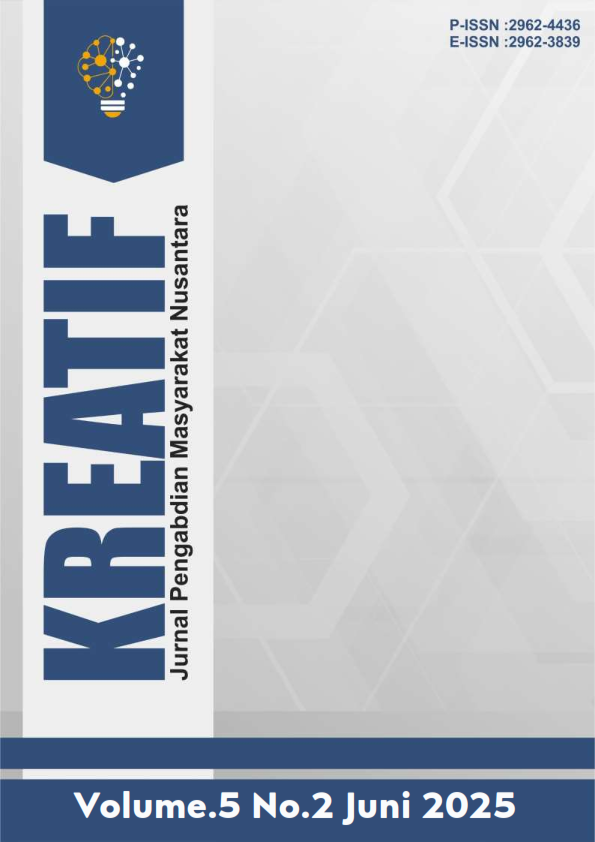Pendampingan Strategis Penyusunan Renstra Perangkat Daerah yang Terpadu dengan RPJMD Merauke 2025–2029
DOI:
https://doi.org/10.55606/kreatif.v5i2.5949Keywords:
Local Government Agencies, Participatory Action Resea, RPJMD, Strategic Plan, Strategic PlanningAbstract
The formulation of Strategic Plans (Renstra) aligned with the Regional Medium-Term Development Plan (RPJMD) is a crucial component in regional development planning systems. However, many local government agencies face institutional and technical challenges in producing high-quality, integrated Renstra documents. This community engagement program aimed to assist local government agencies in Merauke Regency in developing Renstra documents aligned with the 2025–2029 RPJMD using a Participatory Action Research (PAR) approach. The activity was conducted in four groups representing basic service, administrative, technical, and regional management functions. The PAR method was applied to foster active involvement of government staff in identifying strategic issues, setting goals and targets, formulating performance indicators, and determining priority programs. The results showed that the participatory approach effectively improved technical understanding and promoted awareness of result-based planning. Despite challenges such as limited human resources and sectoral data, most agencies successfully developed more structured and responsive Renstra documents. The process also promoted a collaborative dialogue culture between academia and bureaucracy. This program concludes that PAR can serve as an effective model for improving the quality of strategic planning documents and strengthening institutional capacity in regional governments. Recommendations include the need for sustainable capacity-building programs, the formation of internal facilitator teams, and stronger integration between planning and budgeting systems
References
Akhmadi. (2022). Pendekatan participatory action research dalam penguatan kapasitas pemerintah daerah. Jurnal Ilmu Sosial dan Administrasi Publik, 9(1), 55–64.
Arnstein, S. R. (1969). A ladder of citizen participation. Journal of the American Institute of Planners, 35(4), 216–224. https://doi.org/10.1080/01944366908977225
Bryson, J. M. (2018). Strategic planning for public and nonprofit organizations (5th ed.). Jossey-Bass.
Dwiyanto, A. (2011). Mewujudkan good governance melalui pelayanan publik. Gadjah Mada University Press.
Ebdon, C., & Franklin, A. (2006). Citizen participation in budgeting theory. Public Administration Review, 66(3), 437–447.
Guba, E. G., & Lincoln, Y. S. (1989). Fourth generation evaluation. Sage Publications.
Hasibuan, A., & Surbakti, R. (2021). Partisipasi dalam penyusunan dokumen perencanaan daerah. Jurnal Administrasi Publik, 11(2), 88–96.
Huffman, S. A. (2018). Participatory action research and community-based participatory research: Tools for building community–academic partnerships. Health Promotion Practice, 19(1), 15–19. https://doi.org/10.1177/1524839917747023
Indonesia. (2020). Permendagri No. 86 Tahun 2017 tentang tata cara perencanaan, pengendalian dan evaluasi pembangunan daerah. Kementerian Dalam Negeri.
Israel, B. A., Eng, E., Schulz, A. J., & Parker, E. A. (2010). Methods in community-based participatory research for health (2nd ed.). Jossey-Bass.
Juniawati, A. L., Nugroho, L. E., & Santosa, P. I. (2023). Identification of synchronization of the RPJMD and Smart City Master Plan in Indonesia. E3S Web of Conferences, 448, 03020. https://doi.org/10.1051/e3sconf/202344803020
Karyono, H., & Sihombing, A. (2020). Perencanaan strategis dalam pemerintahan daerah. Jurnal Ilmu Administrasi Negara, 17(1), 22–31.
Kemmis, S., McTaggart, R., & Nixon, R. (2014). The action research planner: Doing critical participatory action research. Springer.
Mallakin, M., Motlagh, M. E., & Haghdoost, A. A. (2023). Participatory strategic planning for local health system strengthening. BMC Public Health, 23(1), 1–10. https://doi.org/10.1186/s12889-023-15414-3
Mawikere, Y., & Bakarbessy, T. (2021). Tantangan tata kelola pemerintahan daerah di Papua. Jurnal Otonomi Daerah, 5(2), 87–95.
Miles, M. B., Huberman, A. M., & Saldaña, J. (2014). Qualitative data analysis: A methods sourcebook (3rd ed.). SAGE Publications.
Nurdin, I. (2022). Evaluasi kualitas dokumen renstra berbasis partisipatif. Jurnal Perencanaan Pembangunan, 18(2), 40–52.
Osborne, S. P. (2010). The new public governance? Emerging perspectives on the theory and practice of public governance. Routledge.
Rahman, F., & Mustofa, K. (2022). Partisipasi dan good governance dalam perencanaan pembangunan daerah. Jurnal Transformasi Pemerintahan, 7(1), 14–25.
Sakty, I., Haning, M. T., Nara, N., & Syahribulan, S. (2023). Governance of central and regional planning synchronization networks in Indonesia. Atlantis Highlights in Social Sciences, Education and Humanities, 14, 85–94. https://doi.org/10.2991/ahssh.k.230812.013
Sari, D., & Sumarno, H. (2021). Integrasi perencanaan dan penganggaran daerah: Studi kasus Renstra OPD. Jurnal Kebijakan dan Administrasi Publik, 25(1), 27–39.
Sekretariat Daerah Kabupaten Merauke. (2024). Dokumen konsultasi publik RPJMD Kabupaten Merauke 2025–2029. Pemerintah Kabupaten Merauke.
Smith, B. C. (2007). Good governance and development. Palgrave Macmillan.
Sujarwoto, S. (2017). Evaluasi partisipasi masyarakat dalam perencanaan pembangunan daerah. Jurnal Bina Praja, 9(3), 289–302.
Wibawa, S. (2018). Praktik perencanaan partisipatif dalam pemerintahan daerah. Jurnal Ilmu Pemerintahan dan Sosial Politik, 6(1), 10–21.
Downloads
Published
How to Cite
Issue
Section
License
Copyright (c) 2025 KREATIF: Jurnal Pengabdian Masyarakat Nusantara

This work is licensed under a Creative Commons Attribution-ShareAlike 4.0 International License.








